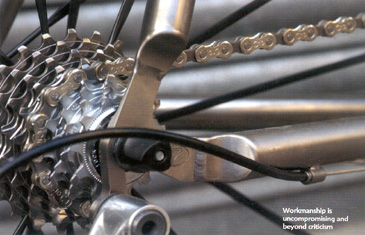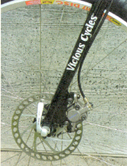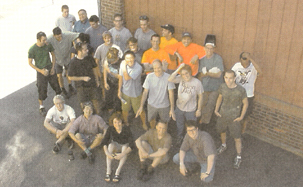Story, Phil Cavell — Photos, Gerard Brown
Last month we examined the virtues of steel and aluminum. This month, Cycle Sport casts an expert eye over those rarer and more exotic options, titanium and carbon-fiber.
Titanium: Seven Axiom
In an ideal world, every country would have at least one bike company steeped in geeky cooldom and armed with an unashamed ‘price is no object’ philosophy. And in this regard the US’s East Coast has rather hogged the scene of late: Fat Chance, Independent Fabrications, Serotta, Merlin and now Seven have all vied for most hip status.
Seven’s torches spluttered into life five years ago when a handful of Merlin’s senior creative staff set up office in Boston, Massachusetts with the lofty notion of only making frames specially to order: Today the company employs 28 people and is one of the USA’s largest fabricators of high-end bespoke excellence, specializing in bike frames for all disciplines, in either steel or titanium.

Frame
The Axiom is Seven’s uncompromising outfit for people who want to live—or look like they live—the racer role to the extreme. It is available as a custom build at no extra cost, although our test bike was specially made for a customer using Seven’s own ‘Signature’ geometry. The Axiom is constructed from Seven’s own seamless Argen 3AI-2.5V titanium tubeset, which is painstakingly externally butted to a tolerance of O.OO1in, or the width of a human hair; whichever seems most appropriate on the day.
The Axiom’s snaked seat stays and chain-stays are unsurprisingly reminiscent of Merlin’s own, and are executed to a comparably high standard as anything crafted by Tom Kellogg (Merlin’s master builder).
Interestingly, Seven eschews shaped tubes in vogue with other manufacturers at the moment, believing the traditional round shape offers a better stiffness to weight ratio, as well as maintaining greater strength integrity compared to ovalized alternatives. The resulting frame looks classical.
A plethora of choices await you when you order your frame, and most won’t cost you a penny more than the ‘basic’ $2,595 frame cost: bosses, tubing, decals, mudguard mounts, geometry sloping top tube—you’ll be at it all day.
Our 56cm bike measured 56.8cm along the top tube and 59.5cm to the top of the seat collar (56cm center-center of the top tube). The 15cm head tube follows the current US trend by being slightly longer and utilizing a 2cm extension above the top tube (also available with 4cm at no extra cost), while the seat and head angles measure 73.5 degrees apiece.
Seven is one of America’s select few art house builders whose construction processes and presentation are among some of the world’s finest—this kind of work is effectively beyond criticism, and only really available for appreciation.
Fork
Seven collaborated with Salt Lake City’s Wound Up Composites to produce a genuine 450–gram fork, which is based around filament–wound carbon legs and 1 1/8in carbon steerer; bonded into a CNC–machined polished aluminum crown and finished off with aluminum dropouts. The cost is a cool $475, but you get a sub–four–pound frame and fork figure to boast about in combination with the Axiom’s 2.981b (1.35kg) frame weight.
Components
Our test bike was prepared by Sigma Sport in Kingston for a very discerning customer with taste and style (not us). It is not often that such a list of rare and desirable parts finds its way onto one frame: Campagnolo Record groupset, Mavic Ksyrium wheels, Chris King headset, Seven Ti stem ($350), Seven Carbon post ($125) etc. Even the headset spacers are titanium and cost $22 a set. Ready to spin on Continental GP3000 tires, the whole rig costs a once–in–a–lifetime $5,049 and weighs a toenail under 16.8lb (16kg).
Ride
My first thought was that the Seven felt a little big for a stock 56cm, partly due to the long seat and top tube, and partly, if I’m honest, because my legs belong to another much shorter person. Hence I would probably choose a 54cm bike for myself and make a necessary change with the stem size. My second thoughts were aesthetic—I felt the Wound Up fork looked a bit too Mtb for the rest of the classic lines of the Axiom. But then I rode the bike and found the front end of the bike to be a total revelation—I have never ridden a bike that steers so quickly and with so little effort. The balance and confidence coming back from the fork, bar and stem combination is astounding, and it took me a couple of hours to stop hitting imaginary apexes four feet too early.

Elsewhere the ride fluctuates between outstanding and excellent. The frame itself feels stiffer than most titanium bikes I have ridden, as there is much more pick–up from the rear triangle than one would expect. The trade–off is that the Seven doesn’t quite have the type of springy, absorbent ride that you look forward to in advancing years for pootling around the country lanes. Maybe the Mavic Ksyriums played their part in giving the Axiom this unexpected aggression, as they are certainly one of the stiffer wheel packages that we’ve tested, as well as being one of the fastest turning. Don’t get me wrong, the bike is still all–day comfortable and satisfying, isolating an estimated one–third more road buzz compared to an all–aluminum frame. The one little problem we had was that the gorgeous looking seat clamp seemed unwilling to get any real bite on the carbon–fiber seatpost—we were constantly stopping to reset the saddle height and retighten the clamp.
Climbing onto any light bike is a delight, but the Seven bestows that something extra to the experience—the bike itself is so classy that you naturally fall into the smooth–as–you–like groove; stay seated in the saddle using languid, powerful pedal strokes as the road kicks right up in front of your face. Or feel the front go stupidly light in your hands—it’s an excellent package.
If you have decided that It is about time that you treated yourself to that once–in–a–lifetime frame purchase, then Seven certainly offers you just about as much scope, and as many options to ‘fill your boots,’ as any other company out there. It is part of that select group of frame–builders who don’t aspire to anything other than passion–infused excellence for people who care about such things.
The Seven Axiom does everything any headbanger race bike will; but with a lot less fuss and drama, and actually encourages you to do the same. It is a race bike for a gentleman and not a hooligan; sure, it is fast and capable, but the expression of its class and ability is an exercise in pure Bostonian understatement.







